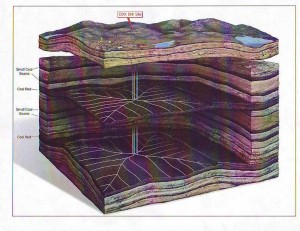Source : YouTube.com by gqoniefh
The above video give a very good technical description about CBM (Coal Bed Meth,ane) Drilling. But my question is; what is the relation of Aceton to the Coal Bed Methane Drilling operations. The CBM issue have been highly debated for the past decade. If human is able to exploit it onshore & it will come to Offshore in near future. With the current scarce of fuel energy; my prediction will be, CBM Drilling will goes offshore (or its already executed somewhere?). Appreciate if anyone can share their experience anything about CBM…
The Video is about An in depth look at surging the well.
- The cavitation process engineer directs the general plan and most surge plans are at the discretion of the company man and then downhole conditions determine how the air tech will build the surge.
- The natural downhole pressure of this well was approximately 500 PSI or 35 Bar
- Coal seams will resist cavitation at first so air and mist pressures will rise quickly
- As the formation starts to fracture and form a cavity, the air tech will pump periodic “Slugs” or “Sweeps” at variable times in variable quantities as the formation becomes more permeable.
- Air techs will always be pumping at least 5 bbls/hour mist added to the compressed air. The mist has a predetermined mixture of foamer or “soap” added to this and the slugs usually have a much greater soap to water ratio.
- Soap ratios can be much higher when CBM formations produce high quantities of water from the coal seam.
- Air techs can take anywhere from 20 minutes to 2 hours to build up a surge
- CBM formations in the San Juan Basin which produce higher amounts of water also produce much higher volumes of methane gas when cavitated
- The coal and gas seen at the initial release of the surge is from above the drill bit in the annulus.
- The surge returns in the opposite order it was pumped into the formation.
- If the gas starts to become less prevalent during the surging process it means the hole is building up too much and needs to be cleaned out or it has “packed off” around the drillstring plugging off the production areas.
- A plugged off hole can be a dangerous situation if the surge has not yet released but it is a common occurence which can be solved by rotating the drillstring and working the pipe up and down. This can often be achieved without opening the pipe rams.
- A trapped surge can push the drillpipe completely out of the hole so it is important for rig personnel to be experienced and aware of this situation before attempting to move the drillstring.
- Natural Surge
- A natural surge is simple shutting the will in and letting the well build up its own pressure. The pressure is released when the pressure stops rising.
- It opens up and cleans out the coal seams in preparation for more air/mist surges.
If you have problem viewing the video, here is the alternative links :
http://www.youtube.com/watch?v=fbM5evcjed0
Source link

Comments
Post a Comment